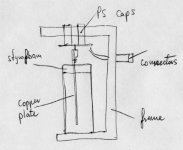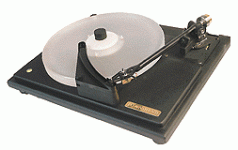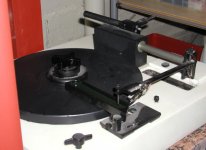I see. You could use a jam pot. Try one with a plastic lid that can be closed very well (peanut butter pots will do I guess). Then mount the chip under the lid and make the lid heavier with glue. Ensure the wires are glued in. And you can try to solder a thin metal plate to the chip. Fill the thingie with oil and throw it in your speak's...
Fedde
Fedde
jh6you said:Post#36.
When the cylinder is under the steady-state vibration, how does the oil isolate the chip from the vibration? I do not even imagine that. I do not think that the oil will absorb the vibration energy and swallow it.

I'm not that familiar with physical aspects of it all, but are you trying to say that the oil can transfer the vibration from a cylinder to the chip, without any loss of those vibrations?
Well it's a fact,
Liquids are EXCELLENT in transmitting vibrations. That's why a sound travels much farther in water than in air by example.
So, if you plan to use liquids to damp vibrations, then your solution don't seems to fit your needs 🙁
Liquids are EXCELLENT in transmitting vibrations. That's why a sound travels much farther in water than in air by example.
So, if you plan to use liquids to damp vibrations, then your solution don't seems to fit your needs 🙁
Elkaid said:Well it's a fact,
Liquids are EXCELLENT in transmitting vibrations. That's why a sound travels much farther in water than in air by example.
So, if you plan to use liquids to damp vibrations, then your solution don't seems to fit your needs 🙁
that's absolutely correct. Because liquids tend to be non-compressable. and sound travels much faster in liquid than in air.
so sinking your amp into a liquid is no different than perfectly surrounding your amp with steel, from the damping perspective.
True, you can hear an outboard motor in water from a very large distance, especially if you're under water!!!
Fedde
Fedde
fedde said:True, you can hear an outboard motor in water from a very large distance, especially if you're under water!!!
Fedde
when I was a child, I used to put my ears to the rail road tracks to hear trains coming from miles away - don't do that at home, 🙂
for the same reason, or I was told, dogs sleep with their ears to the ground: to hear further and quicker.
I would be interested in finding out how this liquid "damping" will do to the sound, 🙂
Hi,
I think what you mean is that you feel the train coming...
So, what's against oil as a damping material all of a sudden?
With tonearms often oil is used to damp vibrations coming from the cartridge/arm.
Some shock absorbers use oil, etc,etc.
Cheers,😉
when I was a child, I used to put my ears to the rail road tracks to hear trains coming from miles away - don't do that at home,
I think what you mean is that you feel the train coming...
So, what's against oil as a damping material all of a sudden?
With tonearms often oil is used to damp vibrations coming from the cartridge/arm.
Some shock absorbers use oil, etc,etc.
Cheers,😉
OK, here's another approach. The chip has attached small copper plate to help heat transfer. It is also not in the oil, only the copper plate. There is a small PCB and 2 PS caps are used to suspend everything, by using some sort of a frame.
I'm still influenced by the idea of using oild to damp vibrations, as it was used on certain TT, where there was a bolt attached to the arm, dipped in oil.
I'm still influenced by the idea of using oild to damp vibrations, as it was used on certain TT, where there was a bolt attached to the arm, dipped in oil.
Attachments
fdegrove said:I think what you mean is that you feel the train coming...
no, you hear it coming - well, hearing is feeling of vibration by your ears so you are right too.
fdegrove said:So, what's against oil as a damping material all of a sudden?
With tonearms often oil is used to damp vibrations coming from the cartridge/arm.
Some shock absorbers use oil, etc,etc.
Cheers,😉
those oil damping devices work different than what is proposed here: they have an outlet for the oil. Damping is achieved as oil, specifically high viscosity oil, flows from one part of the device to the other part of the device through a very small hole. By controling the size (and shape) of the hole, you can control the speed of the flow thus the degree of damping - variable damping shocks.
another way to look at this is to check out those ultrasonic welding devices and cleaning machines at a dentist's office. They use liquid to transmit, not damp, high speed vibrations whereever the liquid is. So using oil does nothing to damping but helping vibration getting where it could not have otherwise gone.
millwood said:those oil damping devices work different than what is proposed here: they have an outlet for the oil. Damping is achieved as oil, specifically high viscosity oil, flows from one part of the device to the other part of the device through a very small hole. By controling the size (and shape) of the hole, you can control the speed of the flow thus the degree of damping - variable damping shocks.
another way to look at this is to check out those ultrasonic welding devices and cleaning machines at a dentist's office. They use liquid to transmit, not damp, high speed vibrations whereever the liquid is. So using oil does nothing to damping but helping vibration getting where it could not have otherwise gone.
It doesn't seem to be a case in that design.
Attachments
millwood said:when I was a child, I used to put my ears to the rail road tracks to hear trains coming from miles away - don't do that at home, 🙂
Hi,
Yes, that's true.
Also, speed of sound in iron is almost 6000m/s !!! (343m/s in air)
Regards
Hi,
Ah, the famous Elite Rock.
There at least a few dozen of tonearms that use viscous damping in similar ways.
Regarding the speed of sound:
The higher speed of sound in liquids and solids, compared with gases, is also partly the result of the fact that liquids and solids are usually more dense than gases. Traveling-wave speed generally increases with increasing density and hardness of the medium.
From which I think it's safe to conclude that the use of oil will transmit vibration slowlier than a solid such as aluminium.
Cheers,😉
Ah, the famous Elite Rock.
There at least a few dozen of tonearms that use viscous damping in similar ways.
Regarding the speed of sound:
The higher speed of sound in liquids and solids, compared with gases, is also partly the result of the fact that liquids and solids are usually more dense than gases. Traveling-wave speed generally increases with increasing density and hardness of the medium.
From which I think it's safe to conclude that the use of oil will transmit vibration slowlier than a solid such as aluminium.
Cheers,😉
fdegrove said:From which I think it's safe to conclude that the use of oil will transmit vibration slowier than a solid such as aluminium.
Cheers,😉
but that's not the point of damping, right?
Otherwise, we would all be buildinging amps in vaccum boxes, or suspending them in thin air - some of them do look like that anyway, 🙂
Hi,
Not sure what you mean here...
Let's just say that the time delay allows for energy to be converted to heat.
Within the context of Peter's application I think that the combination of a copper sheet and the viscosity of the oil would render that part of the amp well isolated from external vibrations.
Maybe too much so... 😉
but that's not the point of damping, right?
Not sure what you mean here...
Let's just say that the time delay allows for energy to be converted to heat.
Within the context of Peter's application I think that the combination of a copper sheet and the viscosity of the oil would render that part of the amp well isolated from external vibrations.
Maybe too much so... 😉
fdegrove said:Within the context of Peter's application I think that the combination of a copper sheet and the viscosity of the oil would render that part of the amp well isolated from external vibrations.
Not as well isolated as if the cylinder were simply filled with air. The denser liquid would provide much more efficient coupling to the vibrating cylinder allowing more vibrational energy to be transmitted to the chip.
Think about it. How many molecules of liquid are there per unit volume versus molecules of air per unit volume?
se
That may be true, but also there is a reason for a small heatsink plate, much smaller than regular heatsink, and use of oil to dissipate more heat from the plate. There are tradoffs here and only building a prototype can show the effect of it all.
Peter, as you may be aware water cooling is used extensively with computer hobbyiests, and to an even further degree, some go as far as refridgerants to freeze the cpu well below 0.
Many also use a TEC(Thermoelectric coupler) - a device that creates a thermal difference between its 2 sides by being a transducer(this is what i recall, might be slightly off), but can yeild temperature differences of 60c easily(imagine a thermocooled lm38xx with watercooling against the TEC(aka peltier)?
MWP, who is also a member of this forum and also built an 8 channel, 220wrms lm3886 amp built this:http://pcdb.overclockers.com.au/view.php?name=MWP&page=pics
That would be mostly homebrew,
If you search for computer watercooling of forums such as www.overclockers.com.au
www.overclockers.com
www.hardocp.com
or www.dansdata.com (highly recommended - this guy has alot of technical knowledge which extends WAY beyond plugging up cables inside his computer
as you are in Canada, computer watercooling parts will be very easy. i beleive a company makes a 'spiral' waterblock in toronto canada, and can be picked up cheap cheap.
All you need is the waterblock,radiator,hosing, waterpump and a decent thickness copper sheet to attach to the waterblock.
Many also use a TEC(Thermoelectric coupler) - a device that creates a thermal difference between its 2 sides by being a transducer(this is what i recall, might be slightly off), but can yeild temperature differences of 60c easily(imagine a thermocooled lm38xx with watercooling against the TEC(aka peltier)?
MWP, who is also a member of this forum and also built an 8 channel, 220wrms lm3886 amp built this:http://pcdb.overclockers.com.au/view.php?name=MWP&page=pics
That would be mostly homebrew,
If you search for computer watercooling of forums such as www.overclockers.com.au
www.overclockers.com
www.hardocp.com
or www.dansdata.com (highly recommended - this guy has alot of technical knowledge which extends WAY beyond plugging up cables inside his computer
as you are in Canada, computer watercooling parts will be very easy. i beleive a company makes a 'spiral' waterblock in toronto canada, and can be picked up cheap cheap.
All you need is the waterblock,radiator,hosing, waterpump and a decent thickness copper sheet to attach to the waterblock.
Peter Daniel said:That may be true, but also there is a reason for a small heatsink plate, much smaller than regular heatsink, and use of oil to dissipate more heat from the plate. There are tradoffs here and only building a prototype can show the effect of it all.
But it seems to me that using a larger heatsink in air and isolating the heatsink from the chassis would result in the least amount of vibrational energy reaching the chip.
se
- Status
- Not open for further replies.
- Home
- Amplifiers
- Chip Amps
- Is LM3875 chip waterproof?


